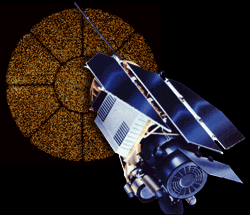The ROSAT Mission
(1990-1999)
ROSAT, the Röntgen Satellite, was an X-ray observatory
developed through a cooperative program between Germany, the United
States, and the United Kingdom. The satellite was proposed by the
Max-Planck-Institut für extraterrestrische Physik (MPE)
and designed, built and operated in
Germany. It was launched by the United States on June 1,
1990. The mission ended after almost nine years, on February 12,
1999.
The U.S. ROSAT Guest Observer Facility (GOF), located at NASA's Goddard
Space Flight Center in Greenbelt, Maryland, was part of the Office
of Guest Investigator Programs
(OGIP) (now called
the HEASARC Office)
in the Astrophysics Science Division
(ASD).
In conjunction with the ROSAT GOF at GSFC, there was also a
ROSAT Science Data Center at SAO in Cambridge, Massachusetts.
This page is intended for members of the scientific community.
For members of the general public, or those interested in general
astronomy/astrophysics information please go to our
Education and Public Outreach
site or the ROSAT Images section.

